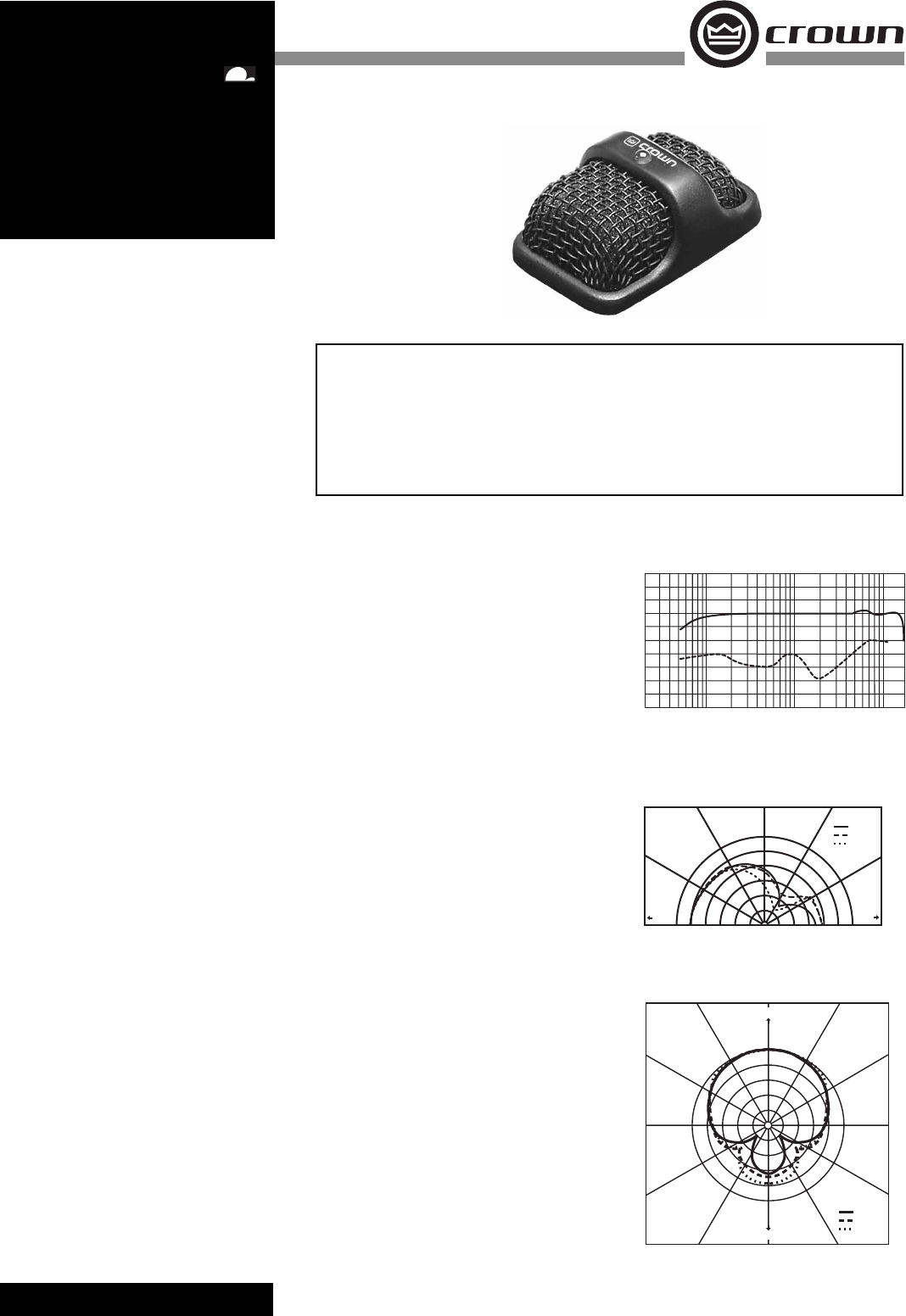
POLAR
PATTERN
MB-4
T
he Crown
®
MB-4 is a miniature boundary
microphone for multi-miking applications
such as teleconferencing, distance learning,
boardrooms, courtrooms, and TV or theatrical
applications. Double-sided sticky tape is pro-
vided for attaching the unit under shelves, on
walls, etc.
Thanks to its supercardioid pickup pattern, the
MB-4 greatly reduces ambient noise and pickup
of room reverberation. The result is a clearer
sound.
The MB-4 has a 15-foot attached cable leading
to an XLR-type output connector with built-in
mic electronics. It is powered by 12-48V phan-
tom power, and is low-impedance balanced.
Features
• Tiny, inconspicuous.
• Can be used without putting holes in the
table.
• Clean, clear, natural sound.
• Low-Z balanced output prevents hum and
high-frequency loss.
• Removable grille assembly can be painted.
How to Paint the Microphone
1. Using a small screwdriver, pry open one side
of the grille, then the other side (Fig. 5).
2. Remove foam liner.
3. Wearing a dust mask, spray-paint the grille
assembly. Be sure grille holes are not clogged.
4. Allow paint to completely dry.
5. Make sure the LED is properly aligned.
6. Carefully place the grille assembly over the
LED, and snap in place.
Installation
1. Typical placement for each mic is at arm’s
length from the user. Install one microphone in
front of each person, or one between every two
people.
If the microphone will be used on a lectern,
install it on an open surface. Do not install it
in a cavity or recessed area as the frequency
response and polar pattern will be degraded.
2. Orient the mic so the word “Crown” is read-
able by the user (right-side-up).
3. Plug a mic cable with a female XLR-type con-
nector into the power module. Connect the other
end of the cable to a phantom power supply. Or
if your mixer has phantom power, connect the
mic cable directly to a mic input and turn on
phantom power.
.
Specifi cations
Type: Phase Coherent Cardioid.
Element: Electret condenser.
Frequency response (typical): 50 Hz to 15,000 Hz at
30 degrees incidence to surface (see Fig. 1).
Polar pattern: Half-supercardioid (supercardioid in
the hemisphere above the primary boundary). See
Figs. 2 and 3.
Impedance: 150 ohms, balanced (recommended load
impedance 1000 ohms or greater).
Open-circuit sensitivity (typical): 22 mV/Pa* (–33
dB re 1 volt/Pa).
Power sensitivity: –30.5 dB re 1 mW/Pa.* EIA rating
–125 dBm.
Equivalent noise level (self-noise): 22 dB SPL typical
(0 dB=0.0002 dyne/cm
2
), A-weighted.
S/N ratio: 72 dB at 94 dB SPL.
Maximum SPL: 120 dB SPL at 3% THD.
Polarity: Positive (inward) pressure on the diaphragm
produces positive voltage on pin 2 with respect to
pin 3.
Operating voltage: Phantom power, 12-48 volts DC
on pins 2 and 3 with respect to pin 1 of output
connector.
Current drain: 4 mA nominal. .
Connector: 3-pin pro audio, XLR-type.
Cable: Permanently attached, black, 15-foot (4.572-
m), 2-conductor shielded cable from mic to power
module or interface. No other cable supplied. Use
two-conductor shielded mic cable from power
module to mixer.
Materials: High-impact molded plastic and steel mesh
mic grille, steel power module.
Finish: Satin black.
Operating temperature range: –10° to +50° C, or
+14° to +122° F.
Net weight: Microphone: 0.7 ounces (19.8 grams).
Power module: 2.8 ounces (78.6 grams).
Dimensions: See Fig. 4.
Included accessories: Double-sided tape for fastening
under shelves, etc., for theatrical applications.
Optional accessories: PH-1A phantom power supply
(1 channel, battery or DC-adapter powered).
*1 pascal = 10 dynes/cm
2
= 10 microbars = 94 dB SPL.
™
Fig. 2
Vertical-Plane Polar Response
Frequency in Hz
Fig. 1
FRONT
REAR
–
20
–15
–10
–5
–0
60° 90° 120°
150°
180°
0°
30°
+
5
1 kHz
5 kHz
200 Hz
+15
+10
+5
dB 0
–5
–10
–15
–20
–25
–30
–35
20 100 1K
10K
130°
0°
Features
• Ideal for teleconferencing, distance
learning, boardrooms and courtrooms
• Has a 15-foot attached cable leading to an
XLR-type output connector with built-in
mic electronics
• Half-supercardioid polar pattern reduces
feedback, room acoustics and background
noise
• Clear, natural sound
• Small and inconspicuous
MINI-BOUNDARY
MICROPHONE
Fig. 3
Horizontal-Plane Polar Response
FRONT
REAR
0°
30°
60°
90°
120
°
150°
180°
210°
240°
270°
300°
330°
–20
–15
–10
–5
–0
1 kHz
5 kHz
200 Hz
Frequency Response




